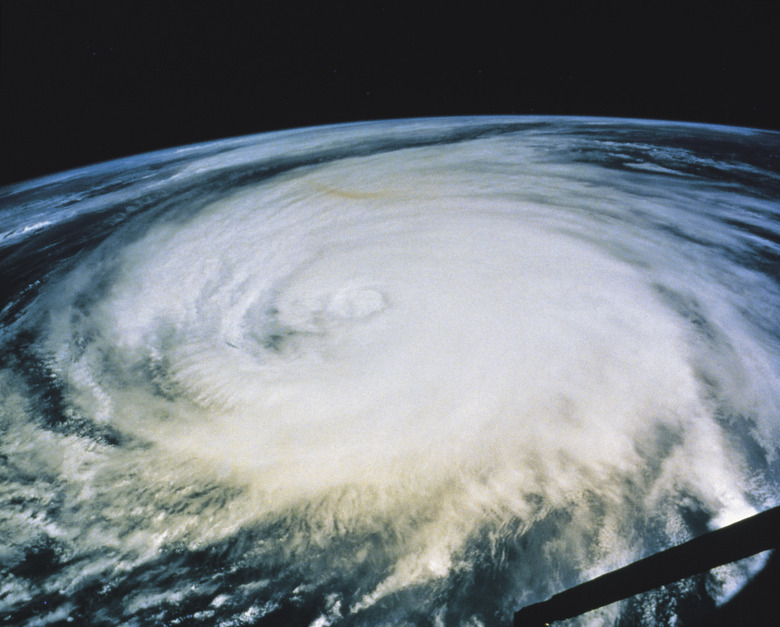How Much Rain Is In A Typical Hurricane?
Hurricanes, or tropical cyclones, are colossal atmospheric disturbances characterized by stormy, high-speed winds rotating around a low-pressure "eye." Feeding off warm ocean waters and solar energy, these storms are both magnificent and cataclysmic, each year killing people and destroying billions of dollars in property in the tropical and mid-latitude regions they chronically afflict. Torrential rains, and often major flooding, typically accompany them.
Hurricane Rainfall
Hurricane Rainfall
A 1981 paper by meteorologist William Gray provides a statistic for the rainfall produced by a typical hurricane. Such a storm sheds about 1.5 centimeters (0.6 inches) of rain daily across a circular area with a 665-kilometer (414-mile) radius. Volume-wise, this translates to 2.1 x 10^16 cubic centimeters (1.3 x 10^15 cubic inches) per day. A given hurricane, of course, may be more or less rainy: Hurricane Amelia, for example, was the rainiest yet to strike the United States since 1956, dumping 1.2 meters (48 inches) along its Texas route in 1978.
Latent Heat
Latent Heat
All that rainfall partly explains a hurricane's immense power. The air sucked into the low-pressure center of a tropical cyclone evaporates warm water off the ocean surface it flows over. The evaporation is driven by solar energy, which is then essentially stored as latent heat in the water vapor. When the vapor condenses into cloud and precipitation — as happens when air spirals upward around the hurricane's eye — that latent energy is released, to the extraordinary degree of some 600 trillion watts for an average storm. That's the equivalent of 200 times the global electricity-generating capability, although only a small fraction goes to power the tempest's whirling winds.
Rainfall Patterns
Rainfall Patterns
The heaviest precipitation in a hurricane tends to be near the center, in the rainbands coiling into the eyewall, the howling rampart that rings the eye. In the context of the storm's lifespan and progression, the most intense rains tend to occur in the vicinity of coastlines as a hurricane makes landfall. Slower-moving storms usually unleash the greatest cumulative rainfall in a given region.
Effects
Effects
The prodigious rains of hurricanes are often one of their most destructive effects, promoting widespread flooding. Better than half the mortality associated with hurricanes in the United States. since the 1970s has been attributed to inland flooding. On the other side of the coin, heavy rains generated by tropical cyclones can be major sources of drought relief in the central and eastern United States, areas into which diminishing cyclones commonly track and expire. A 2007 study out of the University of Georgia suggested that tropical depressions and tropical storms — the less-intense cyclones that may evolve into hurricanes under the right conditions — are more important generators of drought-relieving rainfall than hurricanes in the Southeast, due to their greater frequency.
References
- National Oceanic and Atmospheric Administration: Hurricane Research Division – How Much Energy Does a Hurricane Release?
- National Oceanic and Atmospheric Administration: Tropical Cyclone Point Maxima
- Meteorology: Understanding the Atmosphere; Steven A. Ackerman, John A. Knox
- National Oceanic and Atmospheric Administration: Hurricanes and Extreme Rainfall
- Warwick, Rhode Island: Hurricane Hazards – Rainfall and Flooding
- National Aeronautic and Space Administration: Smaller Storms Drop Larger Overall Rainfall in Hurricane Season
Cite This Article
MLA
Shaw, Ethan. "How Much Rain Is In A Typical Hurricane?" sciencing.com, https://www.sciencing.com/much-rain-typical-hurricane-5043/. 25 August 2017.
APA
Shaw, Ethan. (2017, August 25). How Much Rain Is In A Typical Hurricane?. sciencing.com. Retrieved from https://www.sciencing.com/much-rain-typical-hurricane-5043/
Chicago
Shaw, Ethan. How Much Rain Is In A Typical Hurricane? last modified March 24, 2022. https://www.sciencing.com/much-rain-typical-hurricane-5043/
